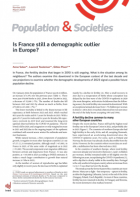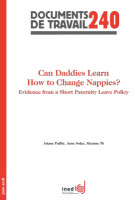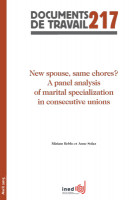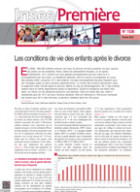
Does parental separation increase the risk of child poverty?
Population and Societies
n° 610, April 2023
https://doi.org/10.3917/popsoc.610.0001
Institut national d’études démographiques (INED), F-93300 Aubervilliers, France
Institut national d’études démographiques (INED), F-93300 Aubervilliers, France
Children’s living standards decrease sharply after parental separation, with an overall decline in their living conditions, especially when they live with a lone mother. Their risk of entering poverty increases as a result. The poverty rate of children in the year of parental separation is much higher (29%) than that of children living with both parents (13%), and the gap remains wide in the following years. The younger the child at the time of separation, the higher the poverty risk. Some children in alternating residence experience poverty with only one of their parents (more often the mother), and others with both parents.
child, separation, divorce, alternating residence, shared custody, joint physical custody, living standard, poverty, France
Table of contents
- Appendix A References
1.
After a separation, the former partners’ standard of living declines, more so for women than for men. Carole Bonnet and Anne Solaz analyse the financial impact of separation on children, most of whom live with their mother after the breakup. In many cases, they experience a drop in living standards, with a high risk of exposure to poverty and substandard living conditions. And what about children in alternating residence, an increasingly widespread custody arrangement? How many experience poverty in one or other of their homes?1
According to the French statistical office (INSEE), 1 in 5 children (21%) in France were living below the poverty line in 2019, i.e. in a household with a standard of living below 60% of the median. While some families are poor before the partners separate, poverty is often a consequence of separation.
Longitudinal data sources on children’s living conditions in France, such as their living arrangements after parental separation, remain scarce. Drawing on INSEE’s Permanent Demographic Sample (Échantillon démographique permanent, or EDP), we constructed a database of children to track their residential trajectories and living standard up to age 7, between 2010 and 2018, before and after parental separation, and in each of their homes if they were in alternating residence, or résidence alternée, an equivalent of joint physical custody (Box 1).
1.1. A greater poverty risk for children after separation
Around 4% of children living with both parents enter poverty each year. The percentage is 5 times higher (21.5%) among children whose parents separate in the year. Almost three-quarters of children who were already poor remain so in the year of separation. This chronic poverty is observable with or without parental breakup.
Poverty rates (which include those entering and remaining in poverty) are much higher for children whose parents have just separated (29%)2 than for children living with both parents (13%) and remain higher 5 years later (23%). This increased rate is due in most cases to entry into poverty after separation and, to a lesser extent, to higher parental separation rates among families that were already poor (structural effects).
The poverty rate varies by the child’s age at separation (Figure 1): the younger the child at the time of separation, the higher the poverty risk. At age 2, more than 35% of children whose parents have just separated are poor versus 22% at age 13.3 Children who are young when their parents separate are more likely to have been poor before the separation. Moreover, the economic gradient of separation risk is steeper when separation4 occurs during early childhood.
The additional child poverty at the time of parental separation (around 17 points for all minors) exists for all minors from broken families whatever the marital status of their parents (Figure 2). This additional poverty is slightly greater for children whose parents were in a consensual union rather than married, mainly because these children were already poorer before separation. The poverty rate is much lower for children whose parents were in a civil partnership (pacte civil de solidarité, or PACS), who are better off on average.
1.2. A drop in living standards after separation that varies by living arrangement
Compared with the year preceding parental separation, the children’s living standard is around 15% lower in the year of separation and 10% lower the following year. While it then starts rising again, the effects of family breakdown persist over the long term: 5 years after separation, their mean standard of living is still 5% below the pre-separation level. This differential would be slightly larger if the situation after separation was compared not with that preceding separation, but with that of children whose parents stay together and whose average disposable income continues to increase over time.
The decrease varies according to the child’s living arrangements after family breakdown. The drop is considerable in the year of separation (24%) if the child is recorded on the tax return as living mainly with the mother, but smaller when recorded as living mainly with the father (Figure 3). The child’s standard of living improves gradually in the years following the separation. The drop is much smaller if the custodial parent repartners [2] and the child lives with either the mother and stepfather or the father and stepmother. That said, fiscal residence with a step-parent is rare just after separation; it concerns just 5% of children with recently separated parents. This proportion tends to increase over time, rising to more than a quarter 5 years later.
The living standard of children in alternating residence (mean of the living standards observed in the two households; Box 2) is also around 10% lower on average than when their parents were still together. However, as the parents who opt for this arrangement are better off on average before separation, their children are less exposed to the risk of poverty than those living mainly with their mother.
1.3. Poor with one parent but not the other?
Measuring the living standard and poverty rate of children with more than one residence is a methodological challenge. While it is straightforward to calculate an average living standard based on the amount of time spent in each parent’s household (here 50–50), it is more difficult to say that children are ‘half poor’ when they are poor in one household but not the other. Given that the parents are separated, they have few pooled resources except for post-separation transfers such as child-support payments (infrequent in the case of alternating residence). These are taken into account in our calculations. Children who are poor in one household may thus suffer the penalties of poverty half of the time, even if the other parent may make up for what they are missing.
Among children in alternating residence who can be observed in their two homes in the year of separation, 6% are poor in both households, while 24% are poor in just one, much more often that of the mother (15%) than of the father (9%), and 70% of children are not poor in either household. Adopting a broad definition of poverty in cases of alternating residence (being poor in at least one household), the general poverty rate of children in the year of separation increases by slightly under 2 percentage points, to 31% rather than 29%.
Poor or not, children living in more than one home may experience substantial differentials in living standards between the first and second parent’s homes. While almost 1 in 5 (16%) of these children have parents with similar living standards (less than 10% difference), 4 in 10 live half of the time with a parent whose living standard is more than 50% higher than that of the other parent.
The tax and benefits system is being progressively adapted in response to the rapid growth of alternating residence to take better account of children living in more than one home. These children can now be recorded in the parents’ tax returns (since 2003), and certain welfare benefits—such as child allowances (since 2007) and housing benefits (since 2019)—can be shared between the parents. The income conditions for receiving welfare benefits in cases of alternating residence also need to be revised. From a methodological viewpoint, the standard poverty indicators should be adapted to take account of these situations.
1.4. Beyond monetary poverty, material and social deprivation
Children’s access to certain resources becomes more limited after parental separation [6]. For example, data from the income and living conditions survey (Box 1) show that the share of children in households that can afford to go away on holiday for at least 1 week per year decreases by 10 percentage points between the year of separation and the following year (Figure 4). Fewer friends are invited to the child’s home in the 4 years following separation, doubtless because the dwelling is smaller and the family have lost contact with some of their friends. For several years following a separation, it is also more difficult for the household to cover unexpected expenses, to give gifts, to replace old furniture, or own a car. Many aspects of children’s living conditions are adversely affected by parental separation. The situation improves markedly, however, if the custodial parent finds a new partner.
1.4.1. Box 1. Creating a database of children from the Permanent Demographic Sample
While administrative data are rarely used to track children’s trajectories, this approach has three advantages. First, attrition (loss to observation between one date and the next) is more limited than with survey data as the children can be followed even after they move to a new address. This is essential for analysing the consequences of separation. Second, the available samples are large, making it possible to observe infrequent situations rarely captured in surveys. Third, children in alternating residence can be followed in both of their new households.
France’s Permanent Demographic Sample (Échantillon démographique permanent, or EDP) is a panel of individuals whose data are collected by the French statistical office (INSEE) each year from various statistical sources, such as vital records since 1967, population censuses since 1968, and tax and benefits data since 2011. The sample, including both adults and children, comprises all the individuals born on 16 specific days of the year (4% of the population). The 2019 database of the EDP contains information on 3.7 million individuals. Of these, 752,599 EDP children living in metropolitan France (observed at least once before age 18 since 2011) are followed and matched against the benefits and tax data via information known about the parents [1]. For each child, the EDP data can be used to deduce the family structure, its living standard, and the child’s living arrangements. The child’s ‘fiscal place of residence’* is reported on the parents’ tax return: either living mainly with the mother or the father, or in alternating residence.
Poverty and children’s living conditions
We also used the French part (Statistiques sur les ressources et les conditions de vie [SRCV], 2004–2019) of the European Union Statistics on Income and Living Conditions (EU-SILC) to describe certain aspects of ‘material and social deprivation’ for 1,077 children whose parents separated over the period.
______
* In some cases, this fiscal place of residence may not correspond to the child’s actual place of residence or the one designated by the family court. We deem a child to be in alternating residence when he or she is declared in two separate households or in alternating residence in one of the two fiscal households observed (excluding fiscal households with the same address).
1.4.1. Box 2. A growing preference for alternating residence, but for wealthier parents only
While the most frequent arrangement after separation is for the children to live with their mother and see their father at weekends, the share of separated parents who spend equal amounts of time with their children, i.e. whose children are in alternating residence, has increased markedly in many industrialized countries, including France [3]. According to the most recent data from the Ministry of Justice, alternating residence was the chosen solution for 1 in 5 divorces and 11% of separations of unmarried couples dealt with by the courts in 2012. While percentages may differ due to differences in definitions, scope,* or data sources, the uptrend is clear. Tax data show that alternating child residence is much more frequent among well-off parents and, logically, that parents previously in PACS unions opt for this arrangement much more frequently than previously married parents. The democratization of this option—its progressive adoption by social groups other than socio-economically advantaged parents, as observed in the United States [5]—is still in its early stages.
_____
* The Ministry of Justice records the judge’s decision for parents who go through the courts. It is the parents who declare alternating residence in their tax returns.
Appendix A References
-
[1] Durier S., 2018, L’échantillon démographique permanent a 50 ans: retours sur un dispositif statistique original, 13es Journées de méthodologie statistique de l’Insee, 12–14 June. http://www.jms-insee.fr/2018/S26_1_ACTE_DURIER_JMS2018.pdf
-
[2] Abbas H., Garbinti B., 2019, De la rupture conjugale à une éventuelle remise en couple: l’évolution des niveaux de vie des familles monoparentales entre 2010 et 2015, in Mainaud T., Rioux L. (coord.), France, portrait social, INSEE. https://www.insee.fr/fr/statistiques/4238447?sommaire=4238781
-
[3] Algava É., Penant S., Yankan L., 2019, En 2016, 400 000 enfants alternent entre les deux domiciles de leurs parents séparés, Insee Première, 1728. https://www.insee.fr/fr/statistiques/3689165
-
[4] Carrasco V., Dufour C., 2015, Les décisions des juges concernant les enfants de parents séparés ont fortement évolué dans les années 2000, Infostat Justice, 132. http://www.justice.gouv.fr/statistiques-10054/infostats-justice-10057/les-decisions-des-juges-concernant-les-enfants-de-parents-separes-27681.html
-
[5] Meyer D. R., Cancian M., Cook S., 2017, The growth in shared custody in the United States: Patterns and implications, Family Court Review, 55(4), 500–512. https://doi.org/10.1111/fcre.12300
-
[6] Leturcq M., Panico L., 2019, The long-term effects of parental separation on childhood multidimensional deprivation: A lifecourse approach, Social Indicators Research, 144(2), 921–954. https://doi.org/10.1007/s11205-018-02060-1
We thank Claire Vandendriessche, Alex Sheridan, and Paul Corbel for their assistance. This study was financed by France Stratégie (see online report, France Stratégie website), the Haut Conseil de la Famille de l’Enfance et de l’Âge (HCFEA), LifeObs (France 2030 ANR-21-ESRE-0037), and the Big_stat project (ANR-16-CE41-0007).
This rate of 29% breaks down as 10.6 percentage points for children who remain poor (pre-separation poverty rate [14.5%] × likelihood of remaining poor for these children [72.8%]) and 18.4 points for children who become poor (share of children not poor before separation [85.5%] × likelihood of becoming poor [21.5%]).
Standard of living takes account of the age composition of household members. The poverty rate increases at age 14 partly because higher child costs are used to calculate poverty from this age.
Children living in lone-parent families from birth are not included here.
Cite the article
Carole Bonnet and Anne Solaz, Does parental separation increase the risk of child poverty?, 2023, Population and Societies, no. 609
 This document may be reproduced free of charge on paper or online using our Creative Commons licence.
This document may be reproduced free of charge on paper or online using our Creative Commons licence.






























